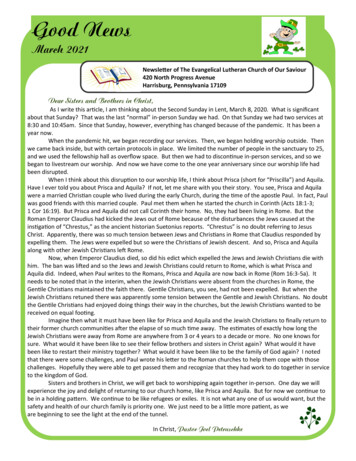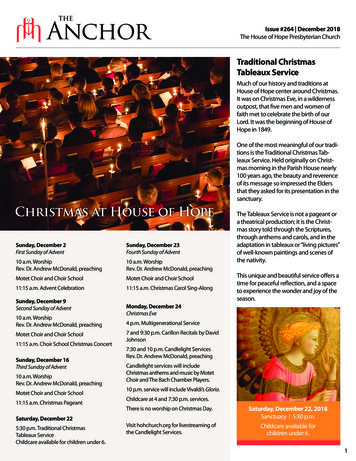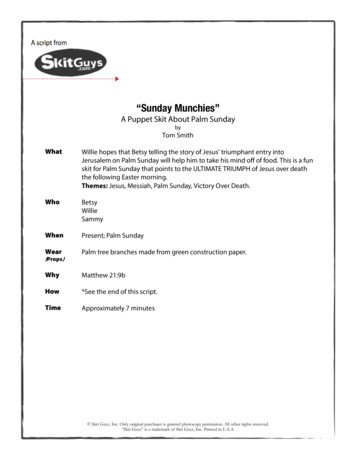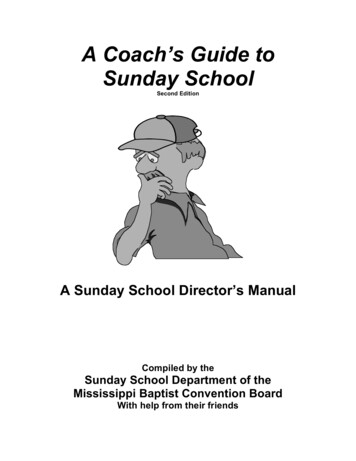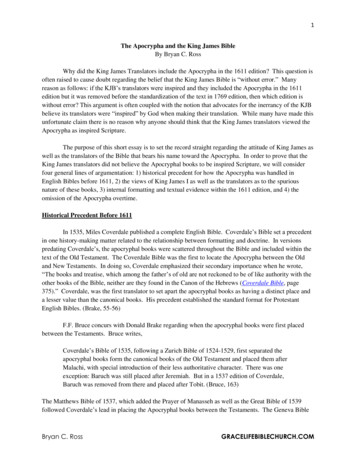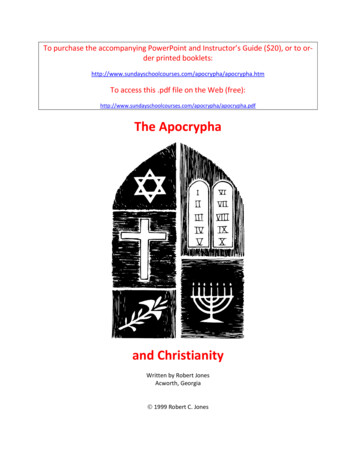
Transcription
To purchase the accompanying PowerPoint and Instructor’s Guide ( 20), or to order printed pha/apocrypha.htmTo access this .pdf file on the Web a/apocrypha.pdfThe Apocryphaand ChristianityWritten by Robert JonesAcworth, Georgia 1999 Robert C. Jones
Christian Theology and History Adult Sunday School CoursesRobert Joneswww.sundayschoolcourses.comI’ve always been a strong believer in adult Sunday School classes and Bible studies in our churches. And manychurches have quality, Biblically-based adult-focused programs. Unfortunately, just as many churches tend todownplay adult education, focusing on children’s education (not a bad thing in itself), or focusing on the needs ofthe “unchurched”, where topics such as church history and theology are often purposely ignored.Yet there is a strong need for adult education focused on both the Bible and the basic tenets and history of theFaith. Among the reasons: Not all adults come from a strong childhood background in the church – adult Sunday School classes/Biblestudies may be their first serious introduction to what Christianity is all aboutChristianity (and especially Evangelical Christianity) is under constant attack from the media and popularculture (movies, music, etc.). We need to give fellow Christians the tools to defend the Faith against attack (or to provide a “ready defense” as Peter says in 1 Peter 3:15)Even adult Christians that have a strong Biblical background often know little about the origins and historyof their FaithTo better meet the needs of adult Christians (both those mature in their Faith, and those just starting out in the“School of Christ”), I’ve written a series of courses that focus on the history of the Christian Church (including theJewish roots), as well as the development of doctrine in the Church. The topics represented in these courses areintended to both further the participant’s walk in the Faith, as well as serve as a starting point for Christian apologetics.While the primary purpose of these courses is for use in churches, they also may be useful for High School and College projects, especially the courses focused primarily on historical aspects.One note: these courses are primarily written from an Evangelical Protestant viewpoint (I come from a ReformedChurch background), but I hope I've given ample time to other points of view throughout the various courses.2
The Apocrypha and ChristianityWritten by Robert JonesAcworth, Georgia 1999To purchase the accompanying PowerPoint and Instructor’s Guide ( 20), or to order printed pha/apocrypha.htmTo access this .pdf file on the Web a/apocrypha.pdfUnless otherwise noted, scripture taken from the Holy Bible, New Revised Standard Version (Copyright 1989, 1993,Zondervan Publishing ourses.com3
Table of ContentsCHRISTIAN THEOLOGY AND HISTORY ADULT SUNDAY SCHOOL COURSES. 2TABLE OF CONTENTS. 4INTRODUCTION . 5Nomenclature .6APOCRYPHA QUIZ . 7HISTORICAL BACKGROUND . 7Timeline .7Alexander the Great .8The Septuagint .9The Maccabean Revolt .11THE GREAT DEBATE – AUTHORITATIVE OR NOT? . 13Timeline .13BOOKS OF THE APOCRYPHA . 15Tobit .16Judith .17Esther (Greek version) .19Wisdom of Solomon .19Sirach (or Ecclesiasticus) .20Baruch .20Letter of Jeremiah .21Prayer of Azariah and the Song of the Three Jews .21Susanna (Chapter 13 of the Greek Daniel) .22Bel & the Dragon (Chapter 14 of the Greek Daniel) .221 Maccabees .232 Maccabees .231 Esdras (Greek for Ezra) .25Prayer of Manasseh .25Psalm 151 .263 Maccabees .262 Esdras .264 Maccabees .291 Enoch .29SUMMARY . 32SOURCES . 32NOTES . 344
IntroductionI’ve taught the Methodist “Disciples” Bible study three times (and have started on #4). One of the thingsthat has been evident in all of my Disciples sessions is the somewhat jarring note presented by the sudden end of the Old Testament (around 430 B.C), and the beginning of the New Testament (around 4B.C.) After spending many months studying the history and theology of the Jews before Christ, suddenlythe students are expected to make a 400-year jump, with no context. Some examples of the perplexitythat this can cause might include: There is nothing about the Maccabean Revolt in the Old or New Testament. As such, it would bedifficult (for example) for Jews to explain the meaning of Hanukkah to their Christian brethrenThere is nothing about Alexander the Great (356 - 323 B.C.) and his impact on Palestine in the Old orNew TestamentsThe Old Testament mentions very little about Satan, demons, or hell. Yet, those topics are commonin the New Testament – what changed in those 400 years?The Old Testament doesn’t really discuss the concept of the resurrection of the dead, yet the Pharisees believe in this doctrine in the New Testament. Where did this doctrine come from?However, there is a set of Jewish documents that add to our understanding of the historical and theological background of the Inter-Testamental period – the Apocrypha. The Apocrypha is, in generalterms, the set of books that appear in the Greek Septuagint, but not in the Hebrew manuscripts of theOld Testament. Most of these books were written in the aforementioned Inter-Testamental period (although some claim to have been written earlier.) While many of these books appear in the RomanCatholic and Eastern Orthodox Bibles (referred to by the Roman Catholics as “deuterocanonical”), manyProtestants (especially those from a Reformed Church background) are not even aware that these booksexist, and may be a bit shocked when they attend a Catholic service, and hear readings from the Book ofSirach, or Tobit!There have been arguments for 2,000 years as to whether the Apocryphal books should be considered“authoritative” – i.e. of the same authority as the Old and New Testament. Some have argued for theirequal authority (Saint Augustine), some have argued for their inclusion in the Bible, but in an appendix(Martin Luther), and some have argued vehemently against their inclusion in the Bible in any form (theviews of 17th century English Calvinists that still impact most Protestant Bible today.) However, whetherone accepts these books as authoritative or not, the Apocrypha (along with the Dead Sea Scrolls) provides valuable historical and theological background to our understanding of the First Century A.D.Christian movement.This primary focus of this booklet will be to examine the Apocrypha from the point of view of its help inilluminating the Jewish roots of Christianity. Three areas of special interest will be considered:1. The valuable historical background provided in the Apocrypha for the Inter-Testamental period, especially the Maccabean Revolt2. The development of certain theological viewpoints in the Inter-Testamental period that would laterflourish under Christianity, such as resurrection of the dead, belief in the devil, demons, and hell, afocus on the end times, belief in a divine Messiah, and a highly developed “angel-ology”3. The great debate over the years in Christian circles as to whether the Apocrypha should be considered authoritative5
NomenclatureThe term “apocrypha” comes from a Greek word meaning “hidden”, or “things hidden away”. In modern parlance, the word is often used to describe things that are spurious, or of questionable authority.The term “Apocrypha” (capital “A”) refers to a collection of books written in the Inter-Testamental period (and into the 1st century). In general, these books (2 Esdras and Prayer of Manasseh are exceptions)appeared in the Greek translation of the Old Testament known as the Septuagint, but not in Hebrewversions of the Old Testament. For the sake of this study, I’ll be using the list of books included in theNRSV Apocrypha, which include: TobitJudithEsther (Greek version)Wisdom of SolomonSirach (or Ecclesiasticus)BaruchLetter of JeremiahPrayer of Azariah and the Song of the Three JewsSusanna (Chapter 13 of the Greek Daniel)Bel & the Dragon (Chapter 14 of the Greek Daniel)1 Maccabees2 Maccabees1 EsdrasPrayer of ManassehPsalm 1513 Maccabees2 Esdras4 MaccabeesI am also including (perhaps somewhat arbitrarily) one other book in this study – 1 Enoch. I’m includingthis book because 1) it is the only Apocryphal book quoted in the New Testament (Jude 14/15) and 2)some 20 copies of 1 Enoch have been found among the Dead Sea Scrolls, perhaps arguing for the ideathat at least one Jewish sect (Essenes) viewed the work as authoritative.There are other apocryphal Jewish writings from the same period, often referred to collectively as thePseudepigrapha, meaning that these works were often written under assumed names (the word means“with false subscriptions”). Some of the works (which will not be studied in this course) in this categoryinclude: Assumption of Moses (see Jude 9)Life of Adam and EveBook of JubileesTestaments of the Twelve Patriarchsand many others.6
Of course, some books in the Apocrypha are also written with “false subscriptions” – Baruch, Letter ofJeremiah, 2 Esdras, Wisdom of Solomon, etc., adding to some of the confusion surrounding what booksare considered to be part of the Apocrypha, and what books are part of the Pseudepigrapha.Apocrypha Quiz1.2.3.4.5.There are no references to Jewish apocryphal works in the New Testament T/FndThe reason for the Maccabean Revolt in the 2 Century B.C. was to kick the Romans out of Palestine T/FThe reason it was called the Maccabean Revolt is because a family named Maccabeus led the fighting T/FThere was no concept of the resurrection of the dead in pre-Christian Jewish theology T/FMartin Luther felt that the books of the Jewish apocrypha were heretical, and should not be read under anycircumstances T/F6. Out of the major Christian denominations in the world, only the Roman Catholic Church includes books fromthe Apocrypha in their Bibles T/F7. One of the reasons that some people feel that the Apocryph is not authoritative is because there are geographical and historical errors in some of its books T/F8. Most of the books of the Apocrypha were included in the Greek translation of the Old Testament known asthe Septuagint T/F9. Saint Augustine believed that the Septuagint translation was inspired by God, and is therefore of equal authority with the original Hebrew T/F10. Possible Hebrew sources for the Septuagint have been found among the Dead Sea Scrolls T/FHistorical BackgroundTimelineDatec. 430 B.C.334-323B.C.323 B.C.320 B.Cc. 250 B.C.200 B.C.c. 188 B.C.175 – 164B.C.173 B.C.171 B.C.c. 169 B.C.c. 167EventMalachi is written (the end of the Old Testament)Alexander the Great conquers the EastAlexander the Great dies of a fever, probably after a drinking bingePtolemy 1 of Egypt conquers JerusalemFirst of the Dead Sea Scrolls are writtenAntiochus III (223-187 B.C.) of Syria defeats Ptolemy V ofEgypt and annexes PalestineAntiochus III defeated in battle by the Romans, and forcedto pay huge war reparations (Peace of Apamea)Rule of Seleucid ruler Antiochus Epiphanes IV, who mayhave been the prototype for the “abomination that causesdesolation” in DanielJewish High Priest Onias III deposed by Antiochus Epiphanes IV and replaced by his brother Jason (priesthood tothe highest bidder)Jason ousted by Menelaus as High Priest (priesthood to thehighest bidder)Antiochus Epiphanes IV loots the Jerusalem Temple treasury Antiochus Epiphanes IV: Desecrates the Temple in Jerusalem Establishes a military garrison in Jerusalem7
Date165 B.C.Dec. 164B.C.163 A.D.162 B.C.162-161B.C.c. 160 B.C.152 B.C.146 B.C.146-134B.C.141 – 37B.C.134-104B.C.103-76B.C.63 B.C.63-40 B.C.37-4 B.C.68 A.D.Event Maccabean revolt under Judas Maccabeus beginsJudas defeats Syrian commander Seron at Beth-horonJudas occupies Temple area, and rededicates it (commemorated by the festival of Hanukkah) Judas fights in Idumea (Edomites), Galilee, Transjordan(Ammonites), Philistia Antiochus Epiphanes IV dies during a campaign in Persia; Regent Lysias has prince declared king as Antiochus V EupatorSyrian throne seized by Demetrius I; Syrian commanderBacchides occupies Jerusalem, and installs Alcimus as highpriest and governor Syrian King Demetrius sends a new general, Nicanor,against Judas; Judas wins a great victory Judas negotiates treaty with RomansDeath of Judas in a battle against Bacchides; Brother Jonathan (youngest son of Mattahias) takes command of therevolutionary forcesJonathan becomes High Priest after cutting a deal withSyrian King Alexander BalasJonathan kidnapped, and then murdered by Syrian GeneralTrypho; brother Simon takes commandRule of Simon as governor and High Priest Through diplomatic and military successes, Judea isfreed from foreign influences (142-141 B.C.) The sons of Simon, John and Judas, defeat Syrian General Cendebeus Simon (and his sons Judas and Mattathias) murderedby his son-in-law PtolemyRule of the Hasmonean dynasty in PalestineRule of John Hyrcanus, eldest son of Simon, as High Priestand ethnarchRule of Alexander Jannaeus – breakout of Civil War between pro-Sadduccean and Pharisec forcesPompey annexes PalestineRule of Hycranus IIHerod the Great rules as puppet king of Palestine (end ofthe Hasmonean Dynasty)Last of the Dead Sea Scrolls are writtenAlexander the GreatOne of the most significant historical events in the period between the Old and New Testaments is the rule of Alexander the Great (b. 356 B.C.; d. 323 B.C.) Alexander, a Macedonian by birth, was the first “world conqueror”. He conquered most of what would today be Greece, Egypt, Turkey, Syria, Palestine, Iran, Iraq, Afghanistan and even parts ofNorthern India. Alexander brought Greek culture to the lands that he conquered, beginning a period of “Hellenization” in the conquered regions that would last for hundreds ofyears. (Photo: Alexander the Great, Library of Congress LC-USZ62-40088)8
So how did all of this impact Palestine and the Jews? After the premature death of Alexander in June of323 B.C., his kin and generals squabbled over who should control his vast empire. In time, three kingdoms would dominate the Mediterranean until the advent of the Roman Empire: Macedon, ruled bythe Antigonids, Egypt, ruled by the Ptolemies, and Syria, ruled by the Seleucids. It is the last two thatimpact our story here, as Palestine was in the middle of these two great empires. While Palestine wouldchange hands on more than one occasion between the competing kingdoms, it was ruled primarily bythe Seleucids. The heavy handedness of one of their kings, Antiochus IV (ruled 175-163 B.C.) led to theMaccabean revolt, which eventually led to a period of independence for the Jews in Palestine.1st Maccabees, one of the great histories of the ancient world, describes the rule of Alexander the Greatand the impact of the breakup of his empire on the Jews in its first chapter:1“ After Alexander son of Philip, the Macedonian, who came from the land of Kittim, had defeated King Darius of the Persians and the Medes, he succeeded him as king. (He had previously become king of Greece.)23He fought many battles, conquered strongholds, and put to death the kings of the earth. He advanced tothe ends of the earth, and plundered many nations. When the earth became quiet before him, he was ex4alted, and his heart was lifted up. He gathered a very strong army and ruled over countries, nations, andprinces, and they became tributary to him.56After this he fell sick and perceived that he was dying. So he summoned his most honored officers, whohad been brought up with him from youth, and divided his kingdom among them while he was still alive.7And after Alexander had reigned twelve years, he died.89Then his officers began to rule, each in his own place. They all put on crowns after his death, and so didtheir descendants after them for many years; and they caused many evils on the earth.” (1 Maccabees1:1-9, NRSV)Map from Barnes Brief History Series, c. 1903The SeptuagintThe Septuagint is a term applied to a Greek translation of the Old Testament, started in the 3 rd centuryB.C. The translation was necessary because, as a result of the Diaspora which occurred in the centuriespreceding, Jews lived all through the Mediterranean, and had to adopt Greek (“Hellenized”) customsand language to survive as “strangers in a strange land”.9
Legend has it that the translation of the Old Testament (or, at least, the Pentateuch) was done at theorder of King Ptolemy II of Egypt (285-246 B.C.) The legend records that 72 Jewish scholars (or 70 insome accounts) produced 72 translations in 72 days – without a word of variation! (The word septuagint derives from “seventy”, and is sometimes represented as LXX). Early Church Father Justyn Martyr(c. 150 A.D.) recounts the legend, and makes it clear that he believes it is true:“*Ptolemy, king of Egypt when he had built the library in Alexandria, and by gathering books from everyquarter had filled it, then learnt that very ancient histories written in Hebrew happened to be carefullypreserved; and wishing to know their contents, he sent for seventy wise men from Jerusalem, who wereacquainted with both the Greek and Hebrew language, and appointed them to translate the books; andthat in freedom from all disturbance they might the more speedily complete the translation, he orderedthat there should be constructed, not in the city itself, but seven stadia off (where the Pharos was built),as many little cots as there were translators, so that each by himself might complete his own translation;and enjoined upon those officers who were appointed to this duty, to afford them all attendance, but toprevent communication with one another, in order that the accuracy of the translation might be discernible even by their agreement. And when he ascertained that the seventy men had not only given the samemeaning, but had employed the same words, and had failed in agreement with one another not even tothe extent of one word; but had written the same things, and concerning the same things, he was struckwith amazement, and believed that the translation had been written by divine power, and perceived thatthe men were worthy of all honor, as beloved of God; and with many gifts ordered them to return to theirown country. And having, as was natural, marveled at the books, and concluded them to be divine, heconsecrated them in that library. These things, ye men of Greece, are no fable, nor do we narrate fictions; but we ourselves having been in Alexandria, saw the remains of the little cots at the Pharos stillpreserved.” (Justin Martyr, Hortatory Address to the Greeks, Chapter 13; emphasis added)The Septuagint held a place of special importance among the early Christians – the vast majority of quotations in the New Testament from the Old are taken from the Septuagint – and not the Masoretic Text(MT) which forms our modern day Old Testament. As there are significant differences between the LXXand MT, the natural inclination is to believe the “original” Hebrew text (MT), instead of the Greek translation. However, Biblical manuscripts found among the Dead Sea Scrolls indicate that the differencesbetween the LXX and the MT are not necessarily because the LXX is a translation, but because the LXX isbased on a different Hebrew source than the MT. If this is true, it may elevate the authoritative of theLXX in the eyes of Biblical scholars (the early Christians may have been right all along in using the LXX!!).Hershel Shanks, editor of Biblical Archeology Review, comments:“One result *of the Dead Sea Scrolls has been to give somewhat more authority to the Greek Septuagint,even though it is a translation. Based on the Hebrew Biblical fragments among the Dead Sea Scrolls, itappears that the differences between LXX and MT are often attributable not to the fact that the LXX is atranslation, but rather to the fact that the LXX translators were working from a somewhat different Hebrew base text.” (Shanks, p. 150)Saint Augustine was a strong proponent of the Septuagint, according divine inspiration to the originaltranslators. Clearly, Augustine considered the Septuagint to be of equal authority with Hebrew versionsof the Old Testament:“For the Septuagint translators are justly believed to have received the Spirit of prophecy; so that, if theymade any alterations under His authority, and did not adhere to a strict translation, we could not doubtthat this was divinely dictated.” (St. Augustine, City of God, p. 652)“And therefore we find that the apostles justly sanction the Septuagint, by quoting it as well as the Hebrew when they adduce proofs from the Scriptures.” (City of God, p. 632)10
So why do we care about the relative authority of the Septuagint compared to early Hebrew versions ofthe Old Testament? Because the Greek Septuagint contains a number of books not in the Hebrew Masoretic Text. Those books (with a couple of additions) make up the Apocrypha.The Maccabean RevoltLeaders of the Maccabean RevoltMattathiasPriestRebel Leader167-165 B.C.Judas MaccabeusRebel Leader165-160 B.C.JonathanRebel LeaderHigh Priest134-104 B.C.SimonRebel LeaderHigh Priest142-135 B.C.John HyrcanusArmy CommanderHigh Priest134-104 B.C.JohnEldest sonRebel leaderEleazarRebel Leaderd. c. 162 B.C.JudasArmy Commanderd. 134 B.C.The Maccabean Revolt, started in 167 B.C. by a Jewish Priest named Mattathias, was one of the definingmoments of Jewish history. One of the high points of the Revolt, the rededication of the Temple, is stillcommemorated today by the Jewish Festival of Hanukkah.At the time of the revolt, Palestine was under the control of the Seleucid King Antiochus Epiphanes IV.Antiochus (possibly the “abomination that causes desolation” in Daniel) was 1) hard up for money and2) determined to Hellenize the territories controlled by him. These two factors would put him on a collision course with the Jews in Palestine.In order to get more money for his depleted treasury, Antiochus IV on at least one occasion looted theJerusalem Temple treasury (c. 169 B.C.). This act followed in the footsteps of his predecessor Selecus IV(187-175 B.C.) who had done the same thing. Antiochus also put the Jerusalem High Priest position upto the highest bidder – High Priests Jason and Menelaus both achieved their positions through bribes tothe Seleucid King.In c. 167 B.C., Antiochus intensified his attempts at Hellenization by desecrating the Temple in Jerusalem. The act is vividly described in 1 Maccabees 1:54-61:54“ Now on the fifteenth day of Chislev, in the one hundred forty-fifth year, they erected a desolating sacri55lege on the altar of burnt offering. They also built altars in the surrounding towns of Judah, and offered56incense at the doors of the houses and in the streets. The books of the law that they found they tore to57pieces and burned with fire. Anyone found possessing the book of the covenant, or anyone who ad58hered to the law, was condemned to death by decree of the king. They kept using violence against59Israel, against those who were found month after month in the towns. On the twenty-fifth day of the60month they offered sacrifice on the altar that was on top of the altar of burnt offering. According to the61decree, they put to death the women who had their children circumcised, and their families and thosewho circumcised them; and they hung the infants from their mothers’ necks.” (NRSV)11
These outrages would lead to a revolt that would eventually kick the Seleucids out of Palestine. The revolt was named after the nickname of one of its greatest leaders – Judas Maccabeus, or Judas “thehammer”.The revolt started when a Priest from Modein named Mattathias refused to commit an apostasy ordered by the King’s men in Modein. Mattathias ended up killing both an officer of the king, and a Jewthat agreed to commit the apostasy. 1 Maccabees 2:23-28 describes the scene:23“ When he had finished speaking these words, a Jew came forward in the sight of all to offer sacrifice on24the altar in Modein, according to the king’s command. When Mattathias saw it, he burned with zeal and25his heart was stirred. He gave vent to righteous anger; he ran and killed him on the altar. At the sametime he killed the king’s officer who was forcing them to sacrifice, and he tore down the altar.27Then Mattathias cried out in the town with a loud voice, saying: ‘Let every one who is zealous for the28law and supports the covenant come out with me!’ Then he and his sons fled to the hills and left all thatthey had in the town.” (NRSV)Mattathias may have fled to the hills, but a great revolt would grow out his actions. Mattathias wouldonly live for another year, but the revolt would succeed under the leadership of his five sons – John, Simon, Judas, Eleazer, and Jonathan. Three of them would lead the rebel forces in succession (Judas, Jonathan, and
Of course, some books in the Apocrypha are also written with false subscriptions – Baruch, Letter of Jeremiah, 2 Esdras, Wisdom of Solomon, etc., adding to some of the confusion surrounding what books are considered to be part of the Apocrypha, and what books are part of the Pseudepigrapha. Apocrypha Quiz 1.






